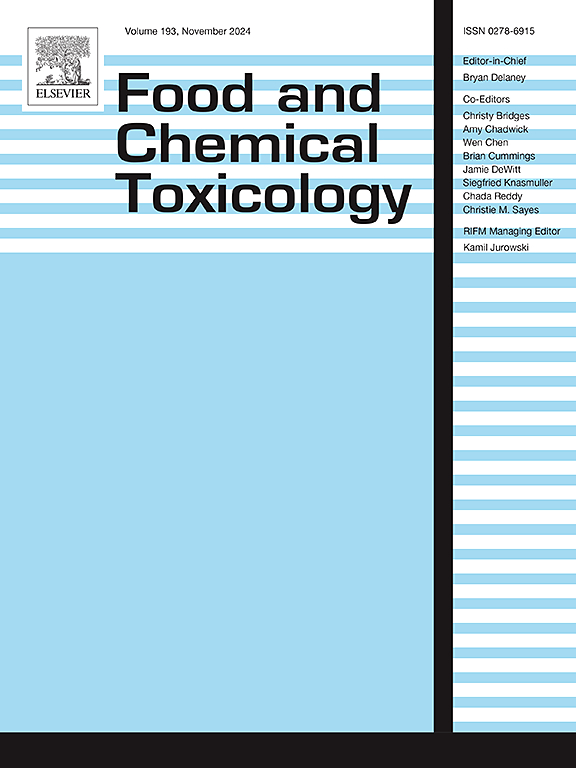Organophosphate esters and their metabolites in Beijing total diets: Occurrence, time trend, and dietary exposure assessment
IF 3.9
3区 医学
Q2 FOOD SCIENCE & TECHNOLOGY
引用次数: 0
Abstract
Organophosphate esters (OPEs) and their metabolites (mOPEs) are emerging pollutants. In this study, 18 OPEs and 10 mOPEs were measured in the 6th and 7th Beijing total diet studies (TDSs), and the dietary intakes of these pollutants by Beijing adults were estimated to assess related health concerns. Most OPEs and mOPEs had high detecting frequencies in both TDSs, which indicated that various foods in Beijing have been universally contaminated with OPEs and mOPEs. Statistical analysis further confirmed that the levels of both ∑OPEs and ∑mOPEs in the 7th Beijing TDS were significantly higher than those in the 6th study, indicating heavier contamination of both OPEs and their metabolites with time. Along with increasing OPE/mOPE contamination level and food consumption values, significant increases of EDIs were observed during the two studies, with the average EDIs of ∑OPEs increasing from 5.07 to 24.1 ng/kg bw/day, and that of ∑mOPEs increasing from 2.07 to 7.23 ng/kg bw/day. Although a comparison between EDIs and reference of doses (RfDs) indicated that current intakes of OPEs could still not cause significant health risks, the sharply increasing contamination levels and EDIs suggested the necessity to continuously monitor these emerging food contaminants.
北京总膳食中的有机磷酸酯及其代谢物:发生率、时间趋势和膳食暴露评估。
有机磷酸酯(OPEs)及其代谢物(mOPEs)是新出现的污染物。本研究在北京市第六次和第七次总膳食研究(TDS)中测定了 18 种 OPE 和 10 种 mOPE,并估算了北京市成年人从膳食中摄入这些污染物的情况,以评估相关的健康问题。在两次总膳食研究中,大多数 OPE 和 mOPE 的检出频率都很高,这表明北京的各种食物普遍受到 OPE 和 mOPE 的污染。统计分析进一步证实,北京市第 7 次总膳食研究中的∑OPEs 和∑mOPEs 含量明显高于第 6 次研究,表明随着时间的推移,OPEs 及其代谢物的污染程度越来越严重。随着 OPE/OPE 污染水平和食物消耗量的增加,两项研究中的 EDIs 也显著增加,∑OPEs 的平均 EDIs 从 5.07 纳克/千克体重/天增加到 24.1 纳克/千克体重/天,∑mOPEs 的平均 EDIs 从 2.07 纳克/千克体重/天增加到 7.23 纳克/千克体重/天。尽管将暴露限值与参考剂量(RfDs)进行比较后发现,目前摄入的 OPE 仍不会对健康造成重大危害,但污染水平和暴露限值的急剧上升表明,有必要对这些新出现的食品污染物进行持续监测。
本文章由计算机程序翻译,如有差异,请以英文原文为准。
求助全文
约1分钟内获得全文
求助全文
来源期刊

Food and Chemical Toxicology
工程技术-毒理学
CiteScore
10.90
自引率
4.70%
发文量
651
审稿时长
31 days
期刊介绍:
Food and Chemical Toxicology (FCT), an internationally renowned journal, that publishes original research articles and reviews on toxic effects, in animals and humans, of natural or synthetic chemicals occurring in the human environment with particular emphasis on food, drugs, and chemicals, including agricultural and industrial safety, and consumer product safety. Areas such as safety evaluation of novel foods and ingredients, biotechnologically-derived products, and nanomaterials are included in the scope of the journal. FCT also encourages submission of papers on inter-relationships between nutrition and toxicology and on in vitro techniques, particularly those fostering the 3 Rs.
The principal aim of the journal is to publish high impact, scholarly work and to serve as a multidisciplinary forum for research in toxicology. Papers submitted will be judged on the basis of scientific originality and contribution to the field, quality and subject matter. Studies should address at least one of the following:
-Adverse physiological/biochemical, or pathological changes induced by specific defined substances
-New techniques for assessing potential toxicity, including molecular biology
-Mechanisms underlying toxic phenomena
-Toxicological examinations of specific chemicals or consumer products, both those showing adverse effects and those demonstrating safety, that meet current standards of scientific acceptability.
Authors must clearly and briefly identify what novel toxic effect (s) or toxic mechanism (s) of the chemical are being reported and what their significance is in the abstract. Furthermore, sufficient doses should be included in order to provide information on NOAEL/LOAEL values.
 求助内容:
求助内容: 应助结果提醒方式:
应助结果提醒方式:


